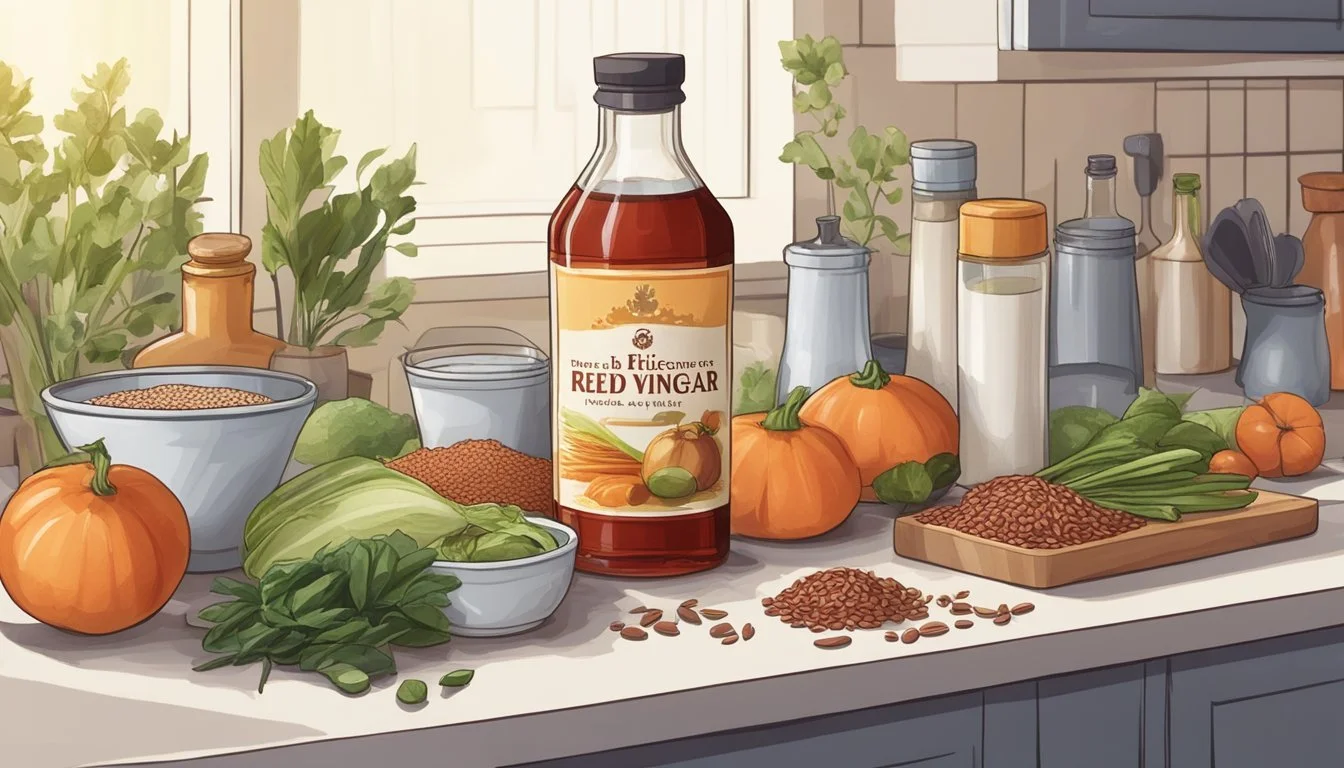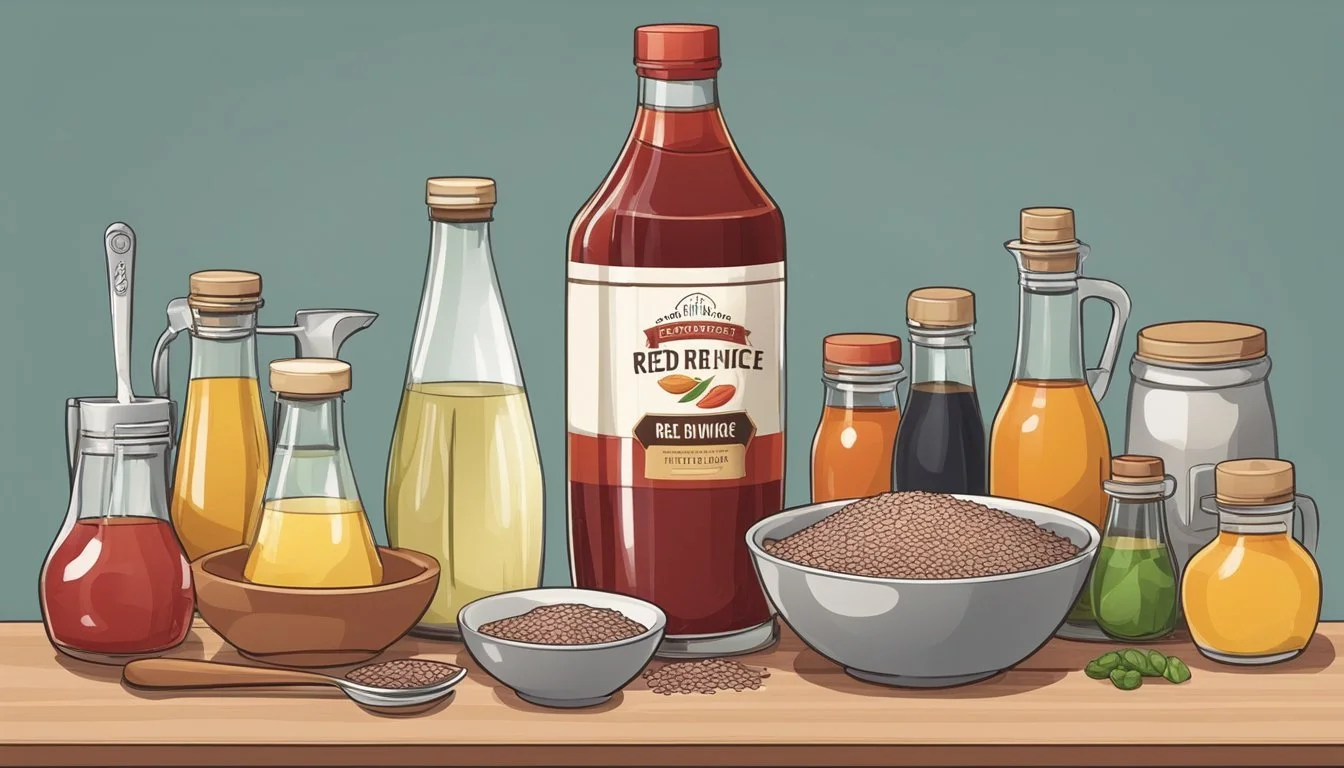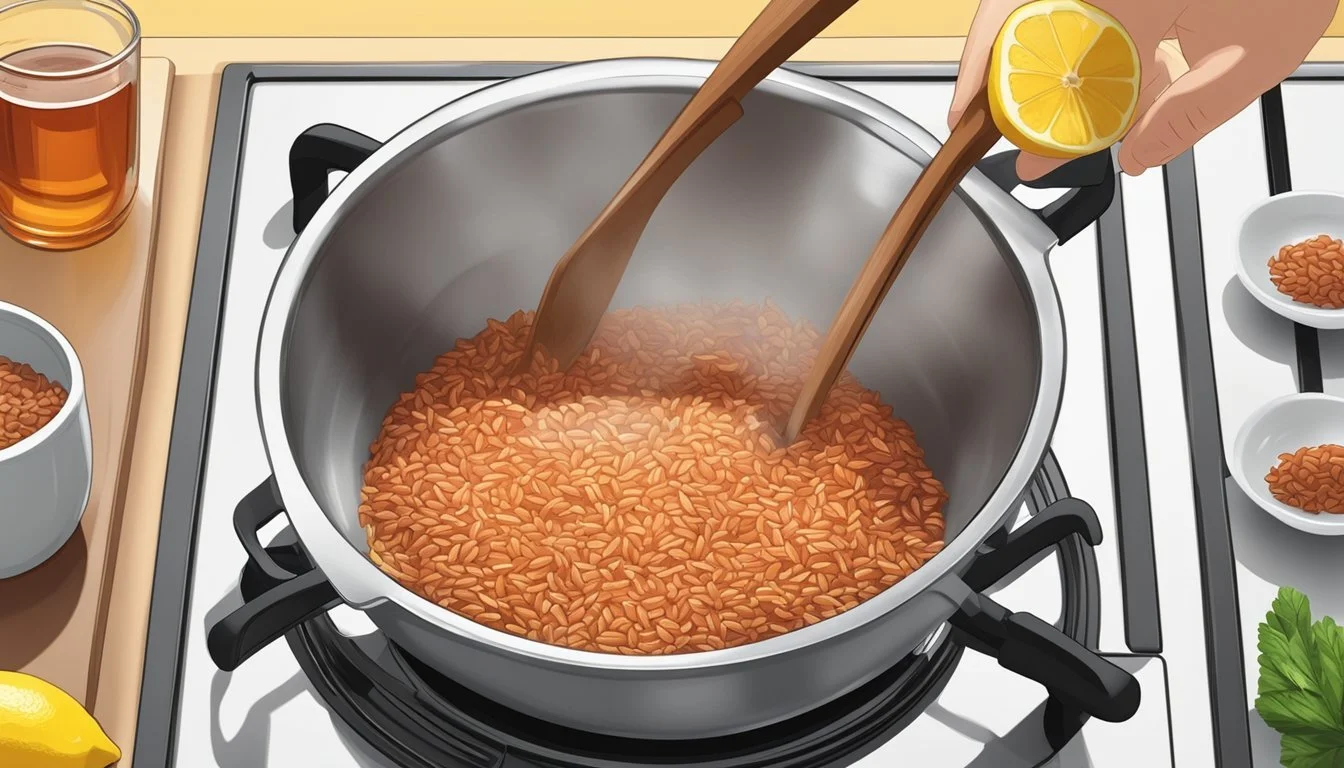Red Rice Vinegar Substitutes
Top Alternatives for Your Cooking Needs
Red rice (What wine goes well with rice?) vinegar, a staple in many Asian cuisines, is celebrated for its tangy yet sweet flavor. It's crafted through fermenting red yeast rice, which contributes to its distinctive color and taste. In culinary practices, red rice vinegar is often used to enhance the flavors of soups, dipping sauces, and salad dressings. Its unique properties make it an essential ingredient for achieving the authentic taste in various dishes. However, there are instances when red rice vinegar may not be readily available, or when dietary restrictions necessitate a substitute.
In such cases, cooks can turn to several alternatives that maintain the integrity of the dish while providing a similar flavor profile. Substitution options include other types of vinegar, such as apple cider vinegar or white wine vinegar, which offer a comparable acidity with subtle taste differences. The key to a successful substitution lies in understanding the flavor characteristics of red rice vinegar and selecting an alternative that complements the original recipe. Adjusting the substitute's proportions or combining it with other ingredients can help achieve a balance close to that of red rice vinegar.
When choosing a substitute, individuals should consider the dish’s flavor complexity and the role of red rice vinegar within it. Some alternatives may be sweeter or more acidic, so adjustments in the recipe's other components might be necessary to achieve a harmonious overall taste. Moreover, certain substitutes can be more suitable for specific recipes based on their underlying notes and aroma, enhancing the dish rather than simply replicating the missing ingredient.
Understanding Red Rice Vinegar
Red rice vinegar, often found in Asian cuisine, is a staple in various dishes due to its unique flavor profile and acidity. It is made by fermenting red yeast rice with other grains such as sorghum or barley, combining the processes of brewing and fermenting to create its distinct taste.
The acidity of red rice vinegar is milder compared to white rice vinegar, giving it a more subtle tang. This quality makes it suitable for dressings, dips, and as a component in cooked dishes. The fermentation process imbues it with a complex, slightly sweet flavor, often with a hint of smokiness that can enhance the depth of Asian dishes.
Flavor Profile:
Mild acidity
Subtly sweet
Hint of smokiness
Common Uses:
Dressings and dips
Cooked dishes
Pickling
In comparison, red wine vinegar, while similar in color, possesses a stronger acidity and a flavor profile created from fermented red wine, which can be more pronounced and less sweet. Consequently, although red wine vinegar is sometimes suggested as an alternative, one should note the differences in taste when substituting it in recipes that traditionally call for red rice vinegar.
Textural Qualities:
Slightly viscous
Smooth finish
Asian dishes that frequently include red rice vinegar range from stir-fries to cold salads, and the ingredient is prized for its ability to bring a harmonious balance between sweet and sour elements within the cuisine's complex flavor palate.
Common Substitutes for Red Rice Vinegar
When substituting for red rice vinegar, it's essential to match the acidic quality while preserving the unique flavor profile. Each proposed substitute offers a different balance of acidity, sweetness, and tartness, making them versatile for various culinary applications.
Apple Cider Vinegar
Apple cider vinegar is praised for its fruity undertones and comparable acidity, making it a popular substitute. It should be used in a 1:1 ratio when replacing red rice vinegar, and its slight apple flavor can complement dressings and marinades.
White Wine Vinegar
White wine vinegar stands out with its more nuanced flavor and a touch less acidity. It can serve as a substitute particularly well in recipes where a lighter vinegar presence is desirable. Use white wine vinegar in an equal measure to red rice vinegar for best results.
Champagne Vinegar
Champagne vinegar, known for its delicate and mild taste, provides a less assertive flavor than red rice vinegar. It works well in dishes that require a subtle vinegar hint without overpowering other ingredients. Substitute it using a 1:1 ratio.
Lemon Juice
Fresh lemon juice adds a bright, citrusy zing to recipes, emphasizing tartness over sweetness. It's an excellent substitute for red rice vinegar in salad dressings or when a fresh pop of flavor is needed. Adjust sweetness and dilution to align with the desired flavor profile.
Lime Juice
Similarly, lime juice can replicate the tartness of red rice vinegar and infuses a distinct citrus note. It fits perfectly in recipes that can benefit from its tropical zest. Balance it with a bit of sugar to mimic the sweetness that red rice vinegar typically imparts.
Specialty Substitutes and Their Uses
When seeking alternatives to red rice vinegar, specialty vinegars and wines offer a unique set of flavors suitable for various culinary applications. These substitutes are tailored to complement Asian recipes, providing taste profiles that range from sweet and tangy to rich and savory.
Balsamic Vinegar
Balsamic vinegar, known for its deep color and rich flavor, serves as a robust alternative. It imparts a sweet yet tangy note, making it an enticing option for dressing salads. When used in sushi or seafood (What wine goes well with seafood?) dishes, it should be deployed sparingly to avoid overpowering the dish's inherent flavors.
Sherry Vinegar
Sherry vinegar, derived from sherry wine, contributes a mild umami quality. Its nuanced profile enhances the taste of sushi rice as well as Asian-inspired marinades and sauces. Its compatibility with seafood dishes makes it a fitting substitute in recipes calling for red rice vinegar.
Mirin
Mirin, a sweet Japanese rice wine, delivers a balance of sweetness and a subtle hint of umami flavor. An ideal choice for glazes and broths, mirin's lower alcohol content compared to sake makes it a gentle but effective enhancer in delicate dishes.
Sake
Sake, another Japanese rice wine, is drier than mirin and offers a more mellow sweetness. Its versatility allows it to meld harmoniously into broths or to be used as a base in sauces for sushi. The alcohol in sake also helps to tenderize meat and seafood, adding depth to every bite.
Rice Wine
Lastly, Chinese rice wine serves similarly to the Japanese sake, often used in stir-fry and marinades. Not to be confused with rice wine vinegar, this wine adds a less pronounced acidity and subtle sweetness to dishes, accentuating the umami flavor beloved in Asian cuisine.
Homemade Red Rice Vinegar Alternatives
Creating homemade alternatives to red rice vinegar is straightforward and can yield a tasty and functional replacement for your cooking needs, particularly when the distinctively tangy and slightly sweet profile of red rice vinegar is desired.
Lemon/Lime Juice With Sugar
For a fruity, citrus twist that comes close to mimicking the tangy taste of red rice vinegar, one can utilize lemon or lime juice mixed with sugar. The proportions are crucial for achieving a balanced flavor.
To replace 1 tablespoon of red rice vinegar:
Use 1 tablespoon of lemon or lime juice.
Add 1/2 teaspoon of sugar to round off the sharpness and bring in the sweetness.
This mix should provide the acidity and sweetness reminiscent of red rice vinegar, which is often used in dressings and marinades.
Vinegar and Wine Mix
Combining white vinegar with white wine can result in a substitute with a complexity similar to red rice vinegar. The blend should emphasize the acidity while capturing the subtle fruit notes of red rice vinegar without overshadowing the dish's intended flavors.
Recommended mixture:
1 part white vinegar.
1 part white wine.
One can adjust the proportions slightly to cater to taste preferences. It's important to use unsweetened white wine to maintain the balance of flavors, preventing the mixture from becoming too sweet.
Adjusting Acidity and Sweetness in Substitutes
When substituting for red rice vinegar, maintaining the right balance between acidity and sweetness is crucial. Different substitutes offer various levels of acidity and sweetness, which can be fine-tuned using sweeteners and salt for the desired flavor profile.
Use of Sweeteners
To match the subtle sweetness of red rice vinegar, one can add a sweetening agent. This can be in the form of sugar or honey, depending on the desired flavor subtlety. Typically, if a substitute is more acidic, a small amount of sweetener can be added to achieve balance. A general guideline is:
White vinegar: Half a teaspoon of sugar per tablespoon of vinegar
Apple cider vinegar: Perhaps a pinch, as it is already slightly sweet
Champagne vinegar: Adjust with a minimal amount due to its natural mildness
Balancing with Salt
Salt plays a pivotal role in counteracting excess sweetness and enhancing the overall flavor balance. When an acidic substitute is used, salt can be carefully measured to harmonize the flavors. For instance:
White vinegar: A pinch of salt can temper the sharpness and enhance savory notes
Apple cider vinegar: Salt may be used sparingly due to the presence of fruity undertones
Champagne vinegar: Add salt judiciously to complement the vinegar's delicate nature
In adjusting either sweeteners or salt, one should always start with smaller amounts and incrementally increase as needed, tasting frequently to achieve the desired balance without overpowering the dish.
Culinary Applications of Substitutes
When red rice vinegar is not available, a few select substitutes can be utilized to preserve the flavor profile of the original dish. These alternatives offer a comparable tang and sweetness in a variety of culinary settings.
Dressings and Marinades
In dressings and marinades, the substitute for red rice vinegar should mirror its acidity and mild sweetness. White wine vinegar or champagne vinegar can be used in a 1:1 ratio for red rice vinegar to achieve the desired balance. They blend smoothly into dressings for fresh salads and can tenderize proteins in marinades without overwhelming the dish's inherent flavors.
Example Dressing: Combine white wine vinegar with olive oil, minced garlic, and herbs for a simple vinaigrette.
Marinade Application: Use champagne vinegar with soy sauce and sesame oil for an Asian-inspired marinade for chicken or tofu.
Dipping Sauces and Pickles
Dipping sauces and pickles require a careful mix of acidity and sweetness. Apple cider vinegar is an excellent substitute, despite its stronger flavor; chefs should consider reducing the quantity slightly to prevent overdominance. It imparts a fruity undertone ideal for dipping sauces and the pickling of vegetables that complements both the tang and the sweetness of red rice vinegar.
Dipping Sauce: Mix reduced apple cider vinegar with soy sauce and a hint of honey to create a balanced dip.
Pickles: Use apple cider vinegar in place of red rice vinegar to pickle vegetables such as cucumbers or daikon radish, ensuring the liquid imparts a subtle sweetness.
Cooking Asian Cuisines
Asian cuisines often depend on the distinctive taste of red rice vinegar. A viable option, seasoned rice vinegar offers a similar flavor with added sweetness and saltiness, which can be adjusted according to the recipe demands. When using it as a substitute, the chef should reduce additional sugar and salt from the dish while maintaining the integrity of the traditional taste profiles.
Asian Sauce: Seasoned rice vinegar can be incorporated into stir-fry sauces to bring a gentle acidity and complexity.
Slaws: For slaw recipes that call for red rice vinegar, seasoned rice vinegar can be used directly to dress vegetables like cabbage and carrots.
Considerations for Dietary Restrictions
When considering substitutions for red rice vinegar, one must be aware of dietary restrictions that could influence the choice of an alternative. Rice vinegar, in general, is made from fermented rice and can contain trace amounts of sugar, thereby affecting those on low-sugar diets.
Distilled White Vinegar: This vinegar is a suitable substitute for those with sugar restrictions as it contains no sugar. It is made from grain alcohol and has a sharper flavor.
White Balsamic Vinegar: One should note that white balsamic vinegar may contain more sugar compared to other vinegars and could be less appropriate for those with diabetic concerns or those following a low-carbohydrate diet.
Apple Cider Vinegar (ACV): ACV can serve as a substitute, though it has a distinctly different flavor. It usually contains a small amount of natural sugar from apples, but can fit into many diets due to its overall health benefits.
For those with allergies, it's important to ensure the chosen substitute hasn't been processed or packaged in a facility that handles allergens. Here is a quick breakdown:
Vinegar Type Sugar Content Allergen Consideration Distilled White None Low risk White Balsamic Higher Check label Apple Cider Low Check label
In each case, replacing red rice vinegar should be done at a 1:1 ratio. However, taste adjustments can be made by adding a slight amount of sugar to the alternative if a closer match to the mild sweetness of red rice vinegar is desired. It's crucial for individuals with dietary restrictions to read labels and understand the composition of these substitutes to make an informed decision.
Storage and Shelf Life of Vinegar Substitutes
When considering the storage and shelf life of vinegar substitutes for red rice vinegar, it's essential to understand their fermentation process and acidity. These factors play a significant role in preserving the quality and flavor of the substitutes over time.
Fermentation: Vinegar substitutes, such as mirin or sherry vinegar, have undergone a fermentation process where sugars have been converted to alcohol and then acetic acid. This process grants them a natural preservative quality.
Acidity: Acidity, which ranges in each substitute, is a crucial preservative factor. Higher acidity creates an environment less hospitable to bacteria, extending shelf life.
Here's a brief guide on the storage and estimated shelf life of common vinegar substitutes:
Substitute Storage Condition Shelf Life (Unopened) Shelf Life (Opened) Mirin Cool, dark place 2-3 years 6 months to 1 year White Wine Vinegar + Sugar Cool, dark place Up to 3 years Several months to 1 year Champagne Vinegar Cool, dark place 2-3 years 6 months to 1 year Sherry Vinegar Cool, dark place 2-3 years Up to 2 years Balsamic Vinegar Cool, dark place Indefinite 3-5 years
Vinegars should be stored in a cool, dark place to prevent degradation from light and heat. They typically remain safe to consume beyond these periods, though quality may decline.
Containers used for storage should be airtight to keep out contaminants and prevent oxidation. Glass bottles are preferred for long-term storage because they do not react with vinegar's acidity.
Consistency in temperature and protection from direct sunlight help maintain the quality of the vinegar substitutes, ensuring they remain a suitable alternative to red rice vinegar for the duration of their shelf life.
Pairing Flavors with Food Profiles
In creating culinary dishes, the selection of a vinegar substitute must complement the food's unique flavor profile, texture, and the desired zing without overwhelming the inherent qualities of the dish.
Seafood Dishes
For seafood, a light touch of acidity is essential to enhance the dish's delicate flavors. Apple cider vinegar can be used, respecting its fruity undertone which complements fish well, but should be used sparingly to maintain the balance. Champagne vinegar is recommended for its subtle taste that does not overpower the seafood's natural umami flavor.
Vegetarian Recipes
Vegetarian dishes (What wine goes well with vegetarian dishes?) often rely on the complexity of flavors. White wine vinegar is an ideal substitute in vegetarian recipes, as it provides a gentle acidic taste. Adding a quarter teaspoon of sugar to each tablespoon helps mimic redrice vinegar's sweetness and creates a depth of flavor that pairs well with plant-based ingredients.
Intense Flavors
For dishes requiring a robust flavor, such as those with fermented elements or heavy sauces, the boldness of white vinegar can stand up to the intensity. One should counterbalance its sharpness with a touch of sweetness to accomplish a rounded flavor reminiscent of red rice vinegar. This substitute should be used in equal parts but adjusted according to the dish's heat and umami levels.
Light and Zesty Flavors
When a recipe calls for a citrus flavor or a zesty profile, lemon juice can be a refreshing substitute, offering a different kind of zing. Lemon juice's vibrant citrus flavor pairs well with salads and light sauces, though its acidity is stronger than red rice vinegar. Diluting it with water or using it sparingly can achieve the right balance of zesty flavor and tangy finish.
Understanding the Role of Acidity in Cooking
Acidity is a critical component in the culinary world, playing a fundamental role in balancing the flavor profile of dishes. When chefs add an acidic ingredient, they aim to enhance and contrast the other flavors within a meal. Acidity is not just about imparting a tart or sour taste; it's about creating a harmonious blend that elevates the overall experience.
In cooking, various sources of acidity such as citrus juices, vinegars, and fermented products interact with other ingredients to achieve a desired flavor balance. The presence of acidity can enhance the natural flavors of a dish, cutting through richness or sweetness to prevent it from feeling one-dimensional. Here's a quick guide on how acidity impacts food:
Balances flavors: Acidity counteracts the heaviness of fats and the sweetness of sugars.
Enhances taste: Acidic ingredients can bring out the best in a dish's main components.
Adds brightness: Citrus or vinegar can lift a dish that seems flat or dull.
The acidic taste does much more than just adding a zing to food; it also influences the texture and appearance of certain foods, such as in the case of ceviches where the acid from citrus "cooks" the seafood, or in pickling where it preserves the texture. Chefs must carefully adjust the amount of acidic ingredients to ensure that the tartness complements rather than overwhelms the dish. It's the subtle interplay of flavors and the art of achieving the perfect acidic balance that makes a dish truly stand out.










